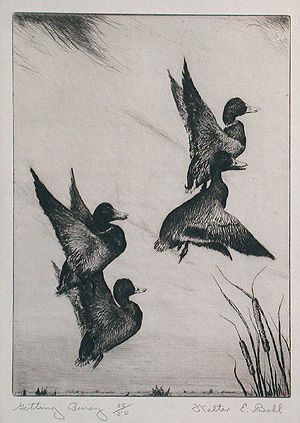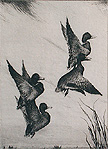| Title: |
Getting Away |
| Artist: |
Bohl, Walter Edward 'Walter Bohl' (Columbus, Wisconsin, 1907 - Scottsdale, Arizona, 1990) |
| Date: |
c. 1935 - 1940 |
| Medium: |
Original Drypoint Engraving and Etching |
| Note: |
Walter Edward Bohl 'Walter Bohl': From the 1920's through the
1940's bird and animal etchings and engravings occupied a very high place
in American art. Devoting himself almost exclusively to the portrayal of
wild fowl, Frank Benson (1862-1951) led the way and became the most famous
etcher in this genre. Other artists, however, created works of equal merit.
Richard Bishop, Roland Clark, Charles Heil and Walter Bohl all created fine
etchings of marsh life and its inhabitants. |
| |
The first career of Walter Edward Bohl was far removed from the
field of fine art. Working in Chicago as an employee of the Bell Telephone
Company he became seriously ill in 1930 and was forced to leave his job.
During his convalescence he began making drawings of birds and wildlife
scenes. Without any intent of selling the work, several drawings came to
the attention of a gallery director who suggested to Walter Bohl to take
up etching. Being the Depression and not in a position to afford the art
supplies Walter E. Bohl industriously fashioned his engraving tools from darning needles
and hand polished his own copper plates. He then manufactured an etching
press from the parts of a discarded clothes wringer. |
| |
Walter Bohl first began selling his etchings and engravings at outdoor
shows in and around the Chicago area. He was at one such show in 1934 when
Mrs. Eleanor Roosevelt purchased one of his etchings for the grand sum of
$1. During the same year his wildlife art came to the attention of the art
editors of Esquire magazine. Until 1943, Walter Edward Bohl was a feature artist
of that publication. As well, he was a commissioned artist for the Federal
Migratory Bird Stamp series, beginning in 1943. |
| |
From 1931 Walter Bohl was a frequent visitor to Arizona's Pinnacle Peak
region. He eventually bought a house near there and built a studio. During
the 1950's he was commissioned to paint murals for the Arizona Bank, Scottsdale. |
| |
Although a fine painter and watercolorist, Walter E. Bohl is today best remembered for his great drypoint engravings of ducks and other migratory birds. His original etchings and engravings are now included in such collections as the National Gallery, Washington, DC, the Department of Library and Archives, Phoenix, Arizona, the Scottsdale Fine Art Collection, the Department of Wildlife and Ecology, University of Wisconsin, and the University of Michigan Museum of Art. |
| Edition: |
Limited edition of fifty impressions, numbered 35/50. |
| Size: |
6 3/4 X 4 7/8 (Sizes in inches are approximate, height
preceding width of plate-mark or image.) |
| |
Framed and Matted with 100% Archival Materials |
| Condition: |
Printed upon fine, hand-made, laid paper and with full margins
as published in Chicago around 1935. Signed, titled and numbered, '35/50',
by the artist in pencil along the lower margin. A superbly printed impression
and in excellent condition throughout. Getting Away is a prime,
original example of the wildlife art of Walter E. Bohl. |
| Price: |
Sold - The price is no longer available. |
| Important Information: |
The artist biographies, research and or information pertaining to all the original works of art posted on our pages has been written and designed by Greg & Connie Peters exclusively for our site, (www.artoftheprint.com). Please visit us regularly to view the latest artworks offered for sale. We will soon be posting an update of our most recent research and include the biographical and historical information pertaining to our next collection of original works of art created by artists throughout the centuries. We hope you found the information you were looking for and that it has been beneficial.
Our Gallery, (Art of the Print / www.artoftheprint.com) guarantees the authenticity of every work of art we sell 100%. Full documentation and certification is provided. We offer a wide selection of international fine art dating from the early Renaissance to the contemporary art period. |




![]()
![]() or
phone Greg & Connie (905) 957-6666
or
phone Greg & Connie (905) 957-6666